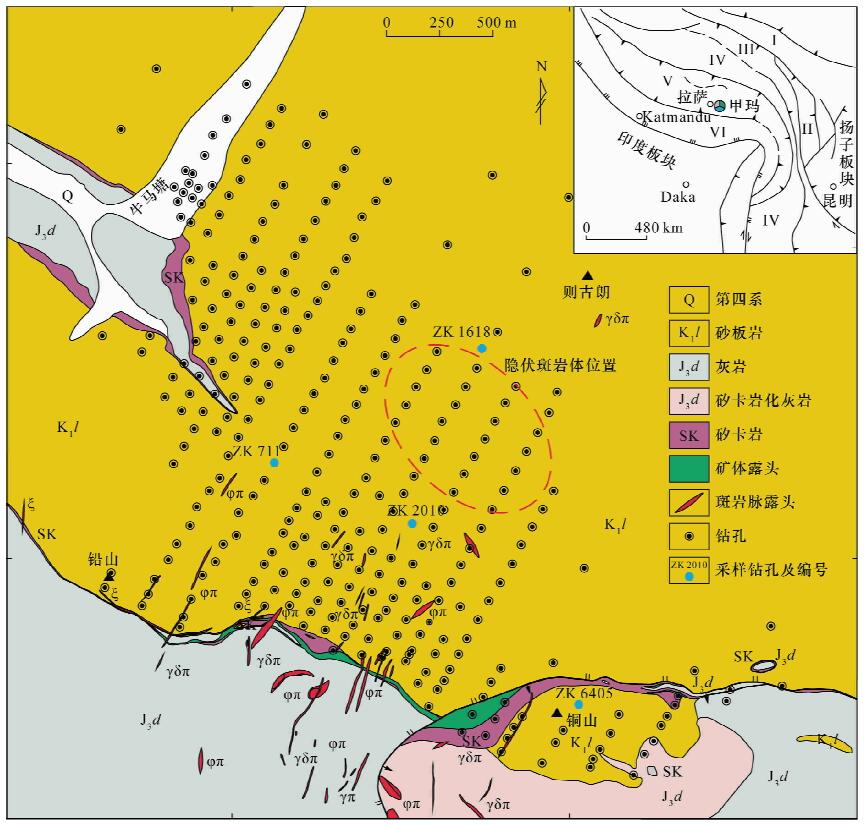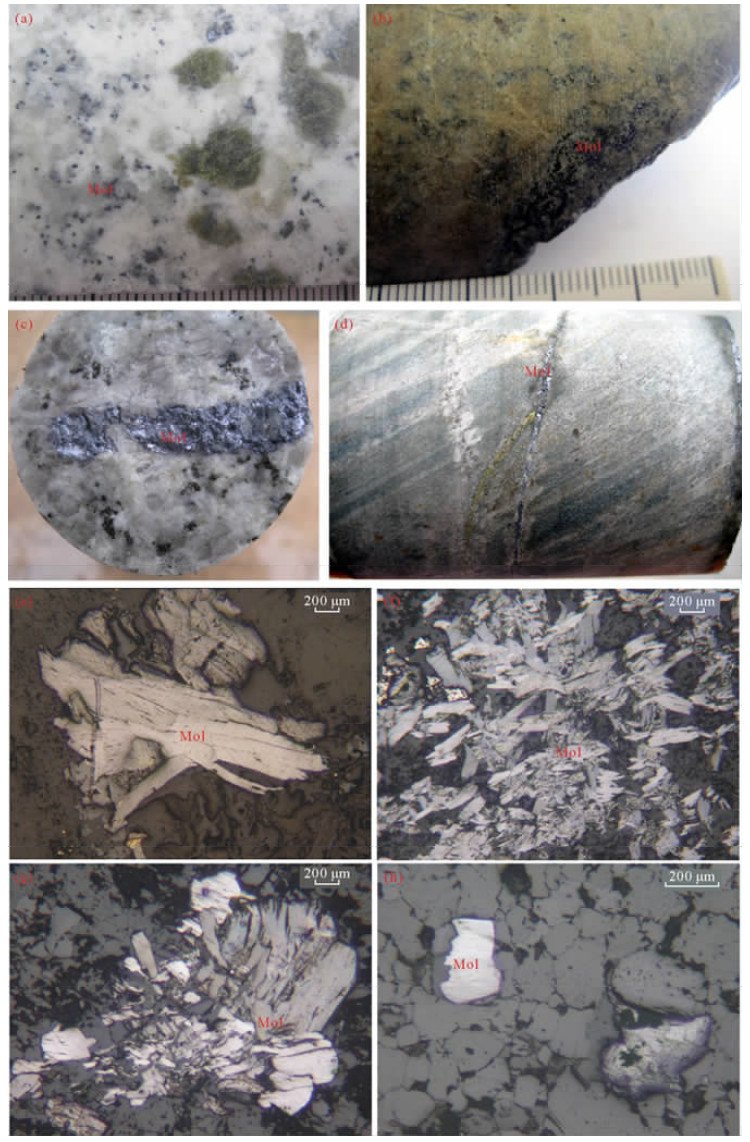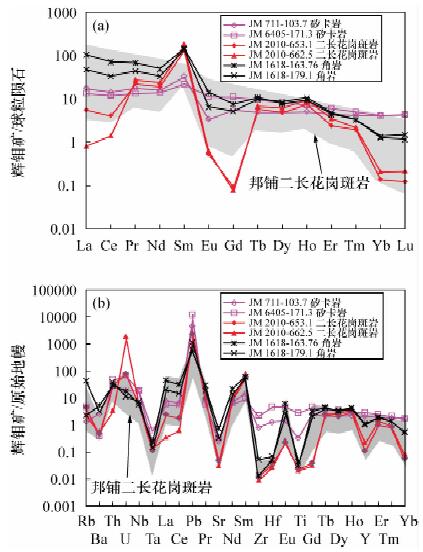ICP-MS Analysis of Rare Earth Elements and Trace Elements of Molybdenite in the Jiama Super-large Copper Polymetallic Deposit, Tibet
-
摘要: 西藏甲玛超大型铜多金属矿床的钼资源量大于100万吨, 辉钼矿是最主要的钼矿物。本文应用电感耦合等离子体质谱法(ICP-MS)分析了不同期次辉钼矿, 研究其稀土元素和微量元素的地球化学特征, 以指示成矿流体的来源与性质, 探讨其成矿机制。结果表明, 辉钼矿的稀土元素总量(39.34~168.1 μg/g)与斑岩、矽卡岩的稀土元素总量相似, 富集轻稀土, 且从早到晚总量增加, 指示流体源自于岩浆。辉钼矿具有明显的Eu、Ce负异常和Sm正异常, 其中Eu负异常指示流体的还原性质; Cu、Pb、Zn等成矿元素含量较高, 指示流体中成矿元素的富集。
-
关键词:
- 甲玛 /
- 辉钼矿 /
- 稀土元素 /
- 微量元素 /
- 电感耦合等离子体质谱法
Abstract: The Jiama super-large copper polymetallic deposit has molybdenum resources in excess of one million tons, and molybdenite is the most important molybdenum mineral. Rare earth elements (REEs) and trace elements of molybdenite from different stages were analyzed by Inductively Coupled Plasma-Mass Spectrometry (ICP-MS) in order to understand the source and nature of ore-forming fluids. Molybdenite contains REE contents ranging from 39.34 to 168.1 μg/g, which is similar to those of porphyry and skarn deposits at Jiama. From early to late stage, REE contents of molybdenite increase and light rare earth elements are relatively enriched, indicating the ore-forming fluids might be derived from magma. Molybdenite shows REE patterns with negative Eu and Ce anomalies, and positive Sm anomaly. Negative Eu anomaly suggest that the ore-forming fluids are relatively reduced. Molybdenite contains high Cu, Pb, Zn, Bi indicating the enrichment of these elements in fluids. -
-
图 2 甲玛不同成矿阶段不同产状辉钼矿
a—成矿早期矽卡岩中细粒浸染状辉钼矿(Mol,JM3110-193); b—成矿早期矽卡岩中细粒辉钼矿(JM6405-173.3); c—成矿主期二长花岗斑岩石英脉中粗粒辉钼矿(JM2010-653.9); d—成矿晚期角岩中辉钼矿细脉(JM1618-176.21); e—片状辉钼矿(JM1616-196.5); f—角岩中鳞片状辉钼矿集合体(JM007-165.23); g—矽卡岩中片状辉钼矿(JM2409-455.85); h—矽卡岩石榴子石颗粒间充填的辉钼矿(JM807-227.66)
Figure 2. Molybdenite with different occurrences at the Jiama's different Metallogenic stages
表 1 西藏甲玛矿床辉钼矿稀土元素含量及其主要特征值
Table 1 Rare earth element concentration (ppm) and feature values of the molybdenite in the Jiama deposit, Tibet
稀土元素 矽卡岩(μg/g) 二长花岗斑岩(μg/g) 角岩(μg/g) JM711
-103.7JM6405
-171.3JM2010
-653.1JM2010
-662.5JM1618
-163.76JM1618
-179.1La 5.634 4.302 0.258 1.774 33.08 15.08 Ce 12 10.06 1.179 3.412 58.7 27.62 Pr 2.248 1.696 3.512 2.85 8.402 5.409 Nd 9.976 8.769 15.02 12.01 30.29 20.44 Sm 6.659 4.466 37.54 27.7 29.56 27.83 Eu 0.255 0.855 0.047 0.040 1.045 0.483 Gd 1.492 2.966 0.020 0.024 1.985 1.348 Tb 0.241 0.474 0.332 0.288 0.515 0.474 Dy 1.643 2.719 2.08 1.607 2.511 2.766 Ho 0.376 0.54 0.722 0.564 0.682 0.766 Er 0.972 1.303 0.756 0.522 0.918 1.009 Tm 0.138 0.166 0.073 0.065 0.106 0.106 Yb 0.903 0.883 0.044 0.029 0.282 0.266 Lu 0.144 0.142 0.007 0.004 0.048 0.037 ∑REEs 42.68 39.34 61.59 50.89 168.1 103.6 LREEs/HREEs 6.223 3.28 14.27 15.4 22.86 14.3 (La/Yb)N 4.206 3.285 3.953 41.24 79.09 38.22 (La/Sm)N 0.532 0.606 0.004 0.04 0.704 0.341 (Gd/Lu)N 1.288 2.596 2.355 0.759 5.14 4.531 δEu 0.248 0.718 0.168 0.148 0.417 0.241 δCe 0.812 0.896 0.298 0.365 0.847 0.736 δSm 4.494 1.757 47.867 43.214 5.658 9.543 注: δEu=EuN/(SmN*GdN)1/2;δCe=CeN/(LaN*PrN)1/2;δSm=SmN/(NdN*EuN)1/2 表 2 西藏甲玛矿床辉钼矿微量元素含量及其主要特征值
Table 2 Trace element concentration and feature values of the molybdenite in the Jiama deposit, Tibet
微量
元素矽卡岩(μg/g) 二长花岗斑岩(μg/g) 角岩(μg/g) JM711
-103.7JM6405
-171.3JM2010
-653.1JM2010
-662.5JM1618
-163.76JM1618
-179.1Li 1.577 6.36 0.249 0.61 3.165 1.996 Be 0.131 0.173 0.021 0.094 0.194 0.329 Sc 2.43 4.504 0.457 0.753 1.886 1.033 Ti 445.3 3883 28.82 32.56 43.77 57.51 V 95.29 65.4 32.16 37.42 53.18 40.06 Cr 67.23 267.9 2.027 44.43 37.66 19.34 Mn 1510 1508 1.632 9.716 84.75 78.61 Co 29.13 23.11 1.036 1.512 1.96 3.336 Ni 573.2 335.2 8.19 9.593 12.4 18.08 Cu 6060 3320 10.74 11.09 25.06 29.17 Zn 2404 2626 5.66 13.02 13.34 24.71 Ga 5.286 4.285 0.143 0.352 1.739 1.564 Ge 1.759 0.95 1.57 1.574 1.864 1.41 As 63.47 135.2 7.616 3.539 8.797 11.41 Rb 0.878 3.173 1.563 3.035 1.48 29.46 Sr 5.562 7.475 0.686 1.079 16.27 6.978 Y 9.78 14.24 1.074 0.542 5.257 4.953 Zr 9.26 26.16 0.106 0.142 0.15 0.603 Nb 13.43 13.96 4.385 4.471 4.318 5.654 Rh 1.139 1.164 1.134 1.1 1.118 1.126 Cd 471.9 486.4 713.1 772 693 778.7 Sn 33.04 57.82 0.572 0.733 0.8 0.947 Sb 6.253 8.649 0.19 0.115 0.667 1.275 Cs 0.479 2.784 0.336 0.575 0.54 6.24 Ba 18.58 2.796 4.144 3.633 38.2 23.31 Hf 0.42 1.567 0.009 0.013 0.016 0.023 Ta 0.012 0.028 0.006 0.005 0.01 0.006 W 240.3 13.05 36.88 31.69 85.48 196.2 Re 0.074 0.03 0.129 0.142 0.024 0.024 Tl 2.035 22.81 0.108 0.151 0.333 5.42 Pb 910.6 2446.1 516.6 465.1 121.4 227.6 Bi 653.7 233.5 54.74 31.04 5.544 48.57 Th 2.375 4.441 0.309 2.902 2.638 3.416 U 0.413 1.568 43.71 1.758 0.408 0.249 总量 13639 15528 148.1 1486.5 1267 1629 Hf/Sm 0.0631 0.3509 0.0002 0.0005 0.0005 0.0005 Nb/La 2.384 3.245 16.996 2.52 0.131 0.375 Th/La 0.422 1.032 1.198 1.636 0.08 0.227 Co/Ni 0.051 0.069 0.126 0.158 0.158 0.185 -
http://www.cnki.com.cn/Article/CJFDTOTAL-CCDZ201206009.htm doi: 10.1016/0016-7037(93)90176-W http://www.cnki.com.cn/Article/CJFDTOTAL-DIZI201301021.htm http://www.cnki.com.cn/Article/CJFDTOTAL-KCDZ201406005.htm http://www.cnki.com.cn/Article/CJFDTOTAL-DZLP201205011.htm http://www.cnki.com.cn/Article/CJFDTOTAL-DZXE201412027.htm http://www.cnki.com.cn/Article/CJFDTOTAL-KCDZ201502005.htm 应立娟. 西藏甲玛铜多金属矿床成矿机制[D]. 北京: 中国地质科学院, 2012: 1-157. Ying L J. The Metallogeny of the Jiama Copper Polymetallic Deposit in Tibet[D]. Beijing: Chinese Academy of Geological Sciences, 2012: 1-157.
http://www.cnki.com.cn/Article/CJFDTOTAL-DZXE201008010.htm Boynton W V. Geochemistry of the Rare Earth Elements: Meteorite Studies[M]//Henderson P. Rare Earth Element Geochemistry. Netherlands: Elsevier Press, 1984: 63-114.
Sun S S, McDonough W F. Chemical Isotopic Systematics of Oceanic Basalts: Implications for Mantle Composition Processes[M]//Saunders A D, Norry M J. Magmatism in the Ocean Basins. London: Geological Society Special Publications, 1989: 313-345.
doi: 10.1016/0169-1368(92)90017-F http://www.cnki.com.cn/Article/CJFDTOTAL-YSXB200304021.htm http://www.cnki.com.cn/Article/CJFDTOTAL-DQXB201004002.htm http://www.cnki.com.cn/Article/CJFDTOTAL-KCDZ201102007.htm http://www.cnki.com.cn/Article/CJFDTOTAL-KCDZ201501006.htm 周云. 西藏墨竹工卡县甲玛铜多金属矿成矿流体特征及演化[D]. 成都: 成都理工大学, 2010: 1-92. Zhou Y. Characteristic and Evolution of Ore-forming Fluids from Jiama Polymetallic Copper Deposit, Mozhugongka County, Tibet[D]. Chengdu: Chengdu University of Technology, 2010: 1-92.
http://www.cnki.com.cn/Article/CJFDTOTAL-GXDX200904009.htm doi: 10.1016/0016-7037(95)00314-P doi: 10.1038/380237a0 http://www.cnki.com.cn/Article/CJFDTOTAL-DQHX200103009.htm -
期刊类型引用(3)
1. 黄建国,陈廷方,李文杰,朱余银. 西昆仑北缘库科西力克钼矿床地质特征及矿床成因浅析. 西南科技大学学报. 2023(01): 47-53 .  百度学术
百度学术
2. 应立娟,王阔,王开建. 西藏驱龙—甲玛—邦铺铜矿集区铅同位素地球化学示踪研究. 岩矿测试. 2016(03): 320-328 .  本站查看
本站查看
3. 松权衡,邢树文,张勇,李超,王岩,于城. 吉林长安堡钼(铜)矿床成矿时代及物质来源:来自辉钼矿Re-Os同位素证据. 岩矿测试. 2016(05): 550-557 .  本站查看
本站查看
其他类型引用(2)




 下载:
下载:


 京公网安备 11010202008159号
京公网安备 11010202008159号